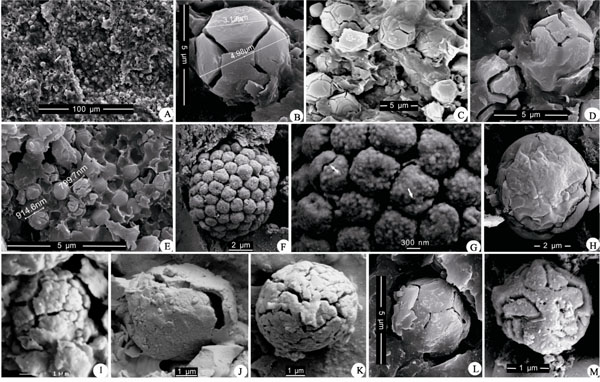@WFS,World Fossil Society,Riffin T Sajeev,Russel T Sajeev
Exceptionally preserved nano-scale spheroids derived from microbial processes and nano-scale fossils have been discovered from the black shales of the Jijiawan section of the Ediacaran Doushantuo Formation in the Yangtze Gorge area of Hubei Province, southern China. The numerous soccer ball-like spheroids are pyritized. Their morphology and abundant preservation may suggest that they could possibly be related to larger spheroids, regardless of the tremendous dimensional gap found in the phosphorite and cherts of the Doushantuo Formation, including those recognized as ‘embryos’. The colony-like spheroids preserved in situ and obtained by acid maceration are compared with known Neoproterozoic microfossils—Bavlinella faveolata (or Sphaerocongregus variabilis). Additionally, nano-scale fossil bodies, characterized by morphological features comparable to living cyanobacteria, fungi and possible unicellular heterotrophic protists were observed in different minor laminae of the black shale samples. This study aims to reveal the aspects of nano-scale biota preserved in the black shale of the Ediacaran Doushantuo Formation, and highlight the taphonomy of microorganisms during the key transition from the anoxic deeper oceans to the oxygenated oceans of the early Ediacaran interval.

Nano-scale spheroids found in the black shales of the Ediacaran Doushantuo Formation in the Jijiawan section, Hubei, China.A–E, I, L, M Soccer ball-like spheroids with probable hollow interior and polygonal cracks, preserved in situ (except specimen M, which was obtained by acid maceration); specimen I displays tuberculiform ornamentation on its surface. F, G colony-like spheroids, which were obtained from organic residues of acid maceration and are compared with known fossils — Bavlinella faveolata. G is a magnification of part of F to show ductile walls (arrow) and possible fine ornamentation on the surface. H, J, K single spheroids with hollow cavities, H was obtained from organic residues of acid maceration, J and K are preserved in situ.
Morphological features similar to those of modern cyanobacteria characterize the preservation of nano-scale fossils [45]. Possible fungal spore and unicellular heterotrophic protists may imply that a diverse nano-scale biota, including prokaryotes and heterotrophic eukaryotes, existed in the early Ediacaran anoxic deeper ocean. Although most of the nano-scale spheroids and fossils obtained from the black shale of the lower part of the Doushantuo Formation were strongly carbonized and mineralized, these findings further reveal aspects of life during this key period of transition from anoxic deeper oceans to oxygenated oceans.
Consequently, the investigation of the biological link that may have existed between such nano-scale microbes and much larger microfossils, particularly acanthmorphic acritarchs, animal embryos and other possible animal remains, during the earlier Ediacaran period is significant. Mineralogically, the studied black shales contain abundant pyrite and gypsum, which alternate within thin laminae. This may signify that redox conditions were fluctuating and a semi-enclosed marine lagoonal palaeoenvironment could have been suitable for the sedimentation and diagenesis of the studied Doushantuo black shales. The fact that many specimens of colony-like spheroids are comparable in their nano-scale biotic associations to Bavlinellafaveolata and other cyanobacteria may suggest that an extraordinarily stressed environment existed during this key geological interval.
Tenger Borjigin1, Leiming Yin2, *, Lizeng Bian3, Xunlai Yuan2, Chuanming Zhou2, Fanwei Meng2, Xiaomin Xie1, Fang Bao1
@WFS,World Fossil Society,Riffin T Sajeev,Russel T Sajeev



 August 6th, 2018
August 6th, 2018  Riffin
Riffin  Posted in
Posted in 